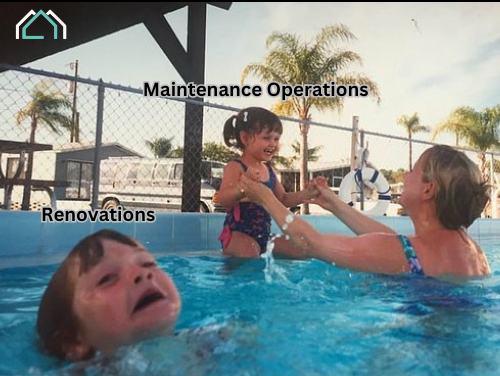Multifamily renovations are critical for maintaining and increasing property value, but too often, they’re managed with outdated, fragmented processes that create unnecessary delays, miscommunication, and cost overruns. Scattered emails, lost approvals, and inconsistent workflows lead to frustration and inefficiency. Without centralization, teams struggle to keep projects on track, vendors aren’t properly coordinated, and budgets spiral out of control. Here’s why a centralized approach isn’t just beneficial, it’s essential.

1. Eliminating Fragmented Communication
Renovation projects involve multiple stakeholders, renovation teams, property managers, maintenance teams, vendors, and regional executives. When communication happens through scattered emails, phone calls, and texts, important details get lost, causing delays and costly mistakes. A centralized system keeps all discussions, approvals, and updates in one place, reducing confusion and ensuring everyone is aligned.
2. Standardizing the Approval Process
One of the biggest renovation bottlenecks is waiting for approvals. Without a structured process, requests can stall for weeks as they bounce between decision-makers. A centralized system automates approvals, ensuring they follow a clear, predefined path, keeping projects moving without unnecessary delays.
3. Enhancing Visibility & Accountability
A lack of transparency leads to duplicated efforts, missed deadlines, and cost overruns. When there’s no single source of truth, teams struggle to track progress and hold stakeholders accountable. Centralization provides real-time visibility into project statuses, deadlines, and responsibilities, ensuring that every step of the process is documented and actionable.
4. Improving Cost Control & Budget Oversight
Decentralized renovation processes lead to inconsistent pricing, unexpected costs, and difficulty tracking expenditures. A centralized platform standardizes pricing agreements with vendors, prevents overages, and provides detailed reporting on costs. This allows property managers to make informed financial decisions and avoid budget surprises.
5. Streamlining Vendor Coordination
Coordinating vendors for flooring, appliances, painting, and general contracting is nearly impossible without a centralized system. Orders get lost, materials arrive late, and projects stall. With centralization, vendor management becomes seamless, tracking deliveries, schedules, and work completion in one place, ensuring the right materials and labor are on-site when needed.
6. Data-Driven Decision-Making
When renovation data is scattered across spreadsheets and disconnected systems, it’s impossible to analyze trends or optimize processes. A centralized system captures all renovation activity in one place, providing valuable insights into costs, completion times, vendor performance, and potential areas for improvement.
7. Speeding Up Turnovers & Increasing NOI
In multifamily operations, speed matters. Every extra day a unit sits vacant due to renovation delays is lost revenue. Centralization streamlines workflows, accelerates project completion, and minimizes downtime, directly impacting Net Operating Income (NOI) and overall profitability.
Conclusion: The Future of Multifamily Renovations is Centralized
Multifamily renovations aren’t just about fixing and upgrading units, they’re about keeping operations efficient, costs controlled, and properties profitable. The traditional, fragmented approach no longer works. To stay competitive, property owners and managers need a system that streamlines every step of the renovation process.
Ready to take control of your renovation process? See how Renowyze brings everything into one place, giving your team the efficiency and visibility they need to scale. Learn more today.
Streamlining Multifamily Renovations
Links
Connect

